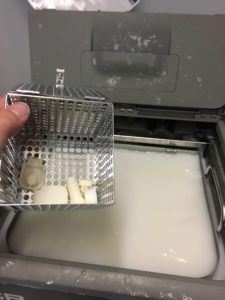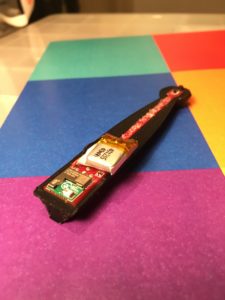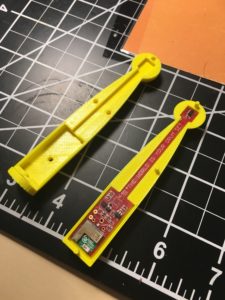 From 3D printed violins and guitars to a modular synthesizer and arpeggiator, 3D printing technology has often been used to help musicians play that funky (and classical) music. A creative group of engineering, design, and music students from the University of Colorado Boulder launched a Kickstarter campaign, currently in its final hours, for Specdrums, which is one of the most interesting musical products I’ve seen in a long time. For people who can’t get enough of tapping away on tabletops, counters, and drums alike, these app-connected rings will actually turn color into sound! The rings allow you to tap on anything with color, from your clothes and graffiti-covered walls to the included 12-color keyboard, to create your own beats and melodies…the world is your own personal sound machine with Specdrums.
From 3D printed violins and guitars to a modular synthesizer and arpeggiator, 3D printing technology has often been used to help musicians play that funky (and classical) music. A creative group of engineering, design, and music students from the University of Colorado Boulder launched a Kickstarter campaign, currently in its final hours, for Specdrums, which is one of the most interesting musical products I’ve seen in a long time. For people who can’t get enough of tapping away on tabletops, counters, and drums alike, these app-connected rings will actually turn color into sound! The rings allow you to tap on anything with color, from your clothes and graffiti-covered walls to the included 12-color keyboard, to create your own beats and melodies…the world is your own personal sound machine with Specdrums.
In addition to the rings themselves, a Specdrums package comes with a beginner’s guide, the 12-Color Specdrums keyboard, a dual micro-USB cable that charges two rings at once, and a 3.5mm AUX cable, so you can plug your mobile device directly into speakers for low latency jamming.
 So, how does it work? To connect up to ten rings to the Specdrums app, available on iOS and Android, you just need to tap the device, and then tap different colors to wirelessly play sounds and musical pitches. You also have the option of selecting different types of instrument sounds, like drum kits and keyboards, and even sound collections, like sound effects and personal recordings – each different sound’s color can be customized to match different colors.
So, how does it work? To connect up to ten rings to the Specdrums app, available on iOS and Android, you just need to tap the device, and then tap different colors to wirelessly play sounds and musical pitches. You also have the option of selecting different types of instrument sounds, like drum kits and keyboards, and even sound collections, like sound effects and personal recordings – each different sound’s color can be customized to match different colors.
 You can also use Specdrums to loop short bits of music, which are called Sloops: layered beats and melodies that have been created within the app using different vocal recordings and instruments. If you want to share your Specdrum creations, you can send Sloops to friends or share on your social media accounts so others can download and open them; they can even contribute further to the Sloops, which makes for a collaborative experience. Specdrums also give you the option to save color, instrument, and sound schemes to use them later – for example, you can make a scheme for all of the colors in your living room or at your desk.
You can also use Specdrums to loop short bits of music, which are called Sloops: layered beats and melodies that have been created within the app using different vocal recordings and instruments. If you want to share your Specdrum creations, you can send Sloops to friends or share on your social media accounts so others can download and open them; they can even contribute further to the Sloops, which makes for a collaborative experience. Specdrums also give you the option to save color, instrument, and sound schemes to use them later – for example, you can make a scheme for all of the colors in your living room or at your desk.
Specdrums rings behave like a pocket-sized Bluetooth MIDI device outside of the app. This means that they can connect to music-making MIDI apps, like GarageBand, and to your laptop so you can play with them on music production software like Ableton Live.
 Specdrums were specifically designed to be “the most accessible, portable musical device” for anyone, no matter their age or musical background (or lack thereof). Not only are they perfect for the percussionist in your life who just can’t stop tapping, Specdrums rings are also a neat alternative to fidget spinners, and are great for kids who enjoy playing with smart, connected toys and teachers looking for STEAM education technology.
Specdrums were specifically designed to be “the most accessible, portable musical device” for anyone, no matter their age or musical background (or lack thereof). Not only are they perfect for the percussionist in your life who just can’t stop tapping, Specdrums rings are also a neat alternative to fidget spinners, and are great for kids who enjoy playing with smart, connected toys and teachers looking for STEAM education technology.
The rings are especially handy for music educators – they’re easy to set up, don’t take up a lot of storage room, and are low-budget to boot. Kids can then use color recognition to learn different musical pitches, make their own instruments using the rings and colored construction paper, and arrange the colors to play a tune.
Specdrums is also open source, so developers who are interested in an open source Bluetooth LE sensor suite are in luck – you can make your own Specdrums application by visiting Specdrums on GitHub. There are many possibilities, from developing a color blindness aid and creating a color scavenger hunt game to building home automation tools and using the accelerometer for gesture recognition.
- 3D printed molds used for Specdrum development
- [Images provided by Specdrums]
The Specdrums rings themselves are not 3D printed, but the silicon prototypes for the rings were made using 3D printed molds, which were created on a Stratasys Objet printer. Often, when we hear of objects being 3D printed, like fruit sensors, chocolate, crayons, and chess pieces, they were actually created using 3D printed molds. 3D printing is helping to expand the offerings from the team, as well, with upcoming releases being perfected thanks to the technology.
Specdrums co-founder and CEO Steven Dourmashkin told 3DPrint.com, “We also used 3D printing to work on other prototypes, that aren’t yet released (including a foot pedal, drumstick, and even marker cap)!”
- 3D printing helped to create prototypes for upcoming drumsticks
- [Images provided by Specdrums]
Specdrums rings are definitely out of development and available via the wildly successful Kickstarter campaign, which as of now has raised more than $175,000 – over 1,100% more than its original goal of $15,000.
The campaign is only up for another several hours, and while all of the early bird specials are gone, you can still get one Specdrums ring (default color is black) for a pledge of $39; it will cost you $74 to get a pair of rings.
What do you think of Specdrums? Discuss this article and other 3D printing topics at 3DPrintBoard.com. You can also discuss in the Facebook comments below.
Subscribe to Our Email Newsletter
Stay up-to-date on all the latest news from the 3D printing industry and receive information and offers from third party vendors.
You May Also Like
Precision at the Microscale: UK Researchers Advance Medical Devices with BMF’s 3D Printing Tech
University of Nottingham researchers are using Boston Micro Fabrication‘s (BMF) 3D printing technology to develop medical devices that improve compatibility with human tissue. Funded by a UK grant, this project...
3D Printing Webinar and Event Roundup: April 21, 2024
It’s another busy week of webinars and events, starting with Hannover Messe in Germany and continuing with Metalcasting Congress, Chinaplas, TechBlick’s Innovation Festival, and more. Stratasys continues its advanced training...
3D Printing Webinar and Event Roundup: March 17, 2024
It’s another busy week of webinars and events, including SALMED 2024 and AM Forum in Berlin. Stratasys continues its in-person training and is offering two webinars, ASTM is holding a...
3D Printed Micro Antenna is 15% Smaller and 6X Lighter
Horizon Microtechnologies has achieved success in creating a high-frequency D-Band horn antenna through micro 3D printing. However, this achievement did not rely solely on 3D printing; it involved a combination...




































